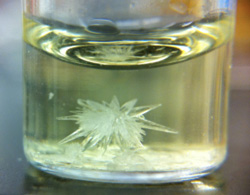 |
| RNA is thought to have acted as a precursor to cellular life |
As it is all about the speed of replication, theoretical models of the RNA world inevitably favour shorter and shorter RNA molecules. The shorter the RNA chain the faster it can replicate and spread; hence the more successful it is.
This principle can be demonstrated very nicely using an experiment known as Spiegelman's Monster. Conducted by a biochemist known as Sol Spiegelman, it involves placing a population of RNA molecules in an environment containing all the equipment needed for replication, including replicative enzymes, ATP as an energy source and nucleotides. Given time the selection pressures will favour shorter RNA sequences. The molecules will be stripped of virtually all their information bar that required for replication itself. This is Spiegelman's Monster - a short and ultra efficient replicator. This, however, creates a problem.
Genomes of most creatures contain far more genetic material than simple replication requires. This encodes for the complexity needed to create elaborate survival strategies such as bodies or brains, but in a prebiotic soup of molecules these would mean very little. In the primordial soup Spiegelman's Monster would rule. So how can we possibly move from this ruthlessly efficient system to more roundabout strategies which do not offer a direct adaptive advantage? In other words the long, complex genetic sequences found in animals or plants. One possible solution to this paradox has been suggested by biophysicists from the University of Munich in Germany.
 |
| Life may have evolved around hydrothermal vents |
The pore is open at the top and at the bottom and filled with a dilute solution of RNA molecules of various lengths. The solution on the hot side, namely the one closer to the stream of super-heated water, would become less dense and rise up through the pore. Some of it would escape at the top, to be replenished by more nutrient-rich fluid entering at the bottom. The remainder would diffuse across to the cold side of the pore and drop back down.
A complex physical effect called thermophoresis causes charged molecules in a solution to accumulate in colder water. The longer chains, having more charge, would do this more often than shorter chains. The shorter RNA chains would be more likely to escape out of the top of the pore. The longer ones, however, would stay trapped inside where, continually fed by nutrients, they could reproduce. In addition the continuous temperature cycling could actually help split the RNA double helix apart, making it easier for it to reproduce, similar to the heating cycles used during PCR experiments.
 |
| PCR machines are sued to rapidly replicate DNA sequences, typically for DNA barcoding |
Braun's experiment explains the genetic paradox of short chain replication predicated by theory versus the long chains observed in practice. By providing an environment favourable for long chain RNA molecules, genetic complexity could increase to the point that the molecules involved could code for entire organisms.
A simple reverse transcription from RNA to DNA would produce the first genome from this complex RNA populations. Biochemist Irene Chen of UC Santa Barbara suggests rock pores hotter on one side than the other could result from solar, as well as hydrothermal, heating, expanding the types of environments that could have favoured the formation of the fist cells.
I think this is a fantastic development to the RNA world hypothesis. Braun's work is an excellent blend of theory and practice which provides a solution to one of the great paradoxes confronting the origin of life. A remnant of this paradox still exists in nature. Bacteria, with their small genomes, are much faster replicators than organsism with longer genomes. As a result they outnumber animals or plants a trillion to one. Nevertheless, the long genome provides ways of overcoming the challenges of staying alive which are impossible for bacteria to utilise. Whilst Spiegelman's Monster is brutally efficient, quantity does not make up for quality.